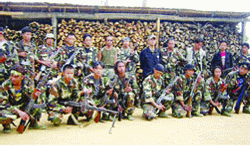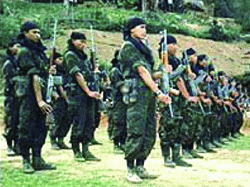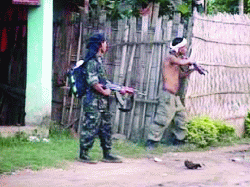Archives
Nagaland: Guns and No Roses
16 persons including 14 NSCN-U cadres and two civilians had been killed. The clash had occurred while NSCN-U cadres were returning after carrying out an attack on an NSCN-IM camp in a nearby area. IM cadres, waiting in ambush, hailed bullets on their unsuspecting rivals, giving them little chance to react, and decamped with their victims’ weapons. With bodies lying scattered, local people converged on the NSCN-IM’s Cease-fire Monitoring Cell at the 4th Mile area in Dimapur, demanding an explanation for such ruthless killings. Subsequent firing by the IM cadres claimed the lives of two civilians.  Apart from the staggering number of deaths in these individual incidents, the incidents conformed largely to the pattern of militant violence in Nagaland. In a State where the two principal militant factions [NSCN-IM and the Khaplang faction (NSCN-K)] have been under a cease-fire agreement with the Centre, Nagaland records a disturbing level of annual fatalities. While the first few years under the ceasefire regime did appear to have restored some normalcy in the state, marked by a visible decline in the level of fatalities, since 2004, violence is on the rise. Fatalities, mostly among the militant ranks as a result of factional clashes, claimed 97 lives in 2004, 99 in 2005, 147 in 2006 and 154 in 2007. Already over 90 lives have been lost in the first five months of the current year.
Apart from the staggering number of deaths in these individual incidents, the incidents conformed largely to the pattern of militant violence in Nagaland. In a State where the two principal militant factions [NSCN-IM and the Khaplang faction (NSCN-K)] have been under a cease-fire agreement with the Centre, Nagaland records a disturbing level of annual fatalities. While the first few years under the ceasefire regime did appear to have restored some normalcy in the state, marked by a visible decline in the level of fatalities, since 2004, violence is on the rise. Fatalities, mostly among the militant ranks as a result of factional clashes, claimed 97 lives in 2004, 99 in 2005, 147 in 2006 and 154 in 2007. Already over 90 lives have been lost in the first five months of the current year.
Interestingly, the NSCN-U, which has been in the thick of things in Nagaland since its inception in November 2007, has been a product of a move to unify the warring NSCN-IM and NSCN-K, which represented a tribal divide that has marked the Naga secessionist struggle since the 1950s. On November 23, 2007, armed cadres and some senior functionaries of both the IM and K factions converged at Hovishe under the Niuland sub-division in the Dimapur District to sign an inter-factional ‘truce agreement’, declaring the unification ofboth warring factions a common goal. The Agreement led to the birth of NSCN-U, which remained stationed at Vihokhu, 25 kilometres from Dimapur. The IM leadership was critical of the development and made it clear that the Agreement was not acceptable to them.
The NSCN-IM’s attitude was mostly rooted in the tribal divide within the group, which was brought into further  prominence by the formation of the NSCN-U. The NSCN-U signified a revolt by the cadres belonging to the Sema tribe within the NSCN-IM against the overbearing presence of the Tangkhul tribe, to which the IM general secretary Thuingaleng Muivah belongs. The Tangkhuls have a marginal presence in Nagaland and are mostly based in the Hill District of Ukhrul in neighbouring Manipur. The NSCN-U has subsequently argued that the IM faction is trying to turn Nagaland into a ‘Gaza Strip’ to rehabilitate the Tangkhuls, with a view to undermine the native Nagas in the State. At least on three occasions this year, NSCN-U cadres have carried out attacks on Tangkhul Nagas in Dimapur.
prominence by the formation of the NSCN-U. The NSCN-U signified a revolt by the cadres belonging to the Sema tribe within the NSCN-IM against the overbearing presence of the Tangkhul tribe, to which the IM general secretary Thuingaleng Muivah belongs. The Tangkhuls have a marginal presence in Nagaland and are mostly based in the Hill District of Ukhrul in neighbouring Manipur. The NSCN-U has subsequently argued that the IM faction is trying to turn Nagaland into a ‘Gaza Strip’ to rehabilitate the Tangkhuls, with a view to undermine the native Nagas in the State. At least on three occasions this year, NSCN-U cadres have carried out attacks on Tangkhul Nagas in Dimapur.
Inevitably, the birth of the NSCN-U has added to the instability parameters within Nagaland. Cadres of the new outfit, mostly drawn from the IM faction, retained the legacy of violence of their parent group. With its proximity to NSCN-K, the NSCN-U also faced no dearth of small arms and ammunition. A glimpse of the array of weapons in the possession of the NSCN-U was provided by a March 11 recovery of an AK-47 rifle with magazine, one .22 rifle, one double barrel 12 Bore gun, one 7.65mm pistol of Italian make with three magazines, one.38 revolver and two Chinese grenades, from six arrested NSCN-U militants in Dimapur.
There is little doubt that the NSCN-U is being supported by the NSCN-K, which has apparently found a way out of its direct confrontations with the IM faction (the two principal factions have clashed only six times this year, thrice in the neighbouring state of Manipur and thrice in Nagaland) and is still being able to inflict losses on its bete noire. Both the NSCN-K and NSCN-U cadres have reportedly operated in tandem and a substantial amount of arms and ammunition has been transferred from the Khaplang camp to the NSCN-U cadres. Realising this, on May 10, the Cease-Fire Supervisory Board (CFSB) had asked the NSCN-K to shift its camp at Vihokhu in the Dimapur District to avoid clashes with the NSCN-IM, since the camp was not a ‘Designated Camp’.  While clashes between the NSCN-IM and the NSCN-K, in previous years, were reported mostly from the Districts of Kohima, Mon, Phek, Zunheboto, Mokokchung and Wokha, Dimapur has emerged almost as the sole location (with the exception of just one incident in Wokha) of the fighting between the IM and U factions. Since its inception, Unification cadres have been based primarily in and around Dimapur and have not ventured into the NSCN-IM strongholds in other Districts. Dimapur, however, hosts NSCN-IM’s command headquarters at Camp Hebron and, consequently, accounts for a large concentration of its total of 3,000 cadres.
While clashes between the NSCN-IM and the NSCN-K, in previous years, were reported mostly from the Districts of Kohima, Mon, Phek, Zunheboto, Mokokchung and Wokha, Dimapur has emerged almost as the sole location (with the exception of just one incident in Wokha) of the fighting between the IM and U factions. Since its inception, Unification cadres have been based primarily in and around Dimapur and have not ventured into the NSCN-IM strongholds in other Districts. Dimapur, however, hosts NSCN-IM’s command headquarters at Camp Hebron and, consequently, accounts for a large concentration of its total of 3,000 cadres.
essed inClearly, ceasefire exists only on paper. Majority of the insurgent cadres do not stay in the designated camps, move about in uniform and with arms, extort, abduct and kill with impunity, all blatant violations of the ground rules laid down by the ceasefire agreements. The outfits even conducted recruitment drives increasing their cadre strength considerably. In 2007, all the eleven districts of the state witncidents of internecine clashes, abductions and killings.
The ceasefire monitoring bodiesin the state, one each for the IM and K factions, lack the mandate and power to impose the ground rules. For years, the Kohima based Ceasefire Monitoring Group (CFMG) chairman Lt. Gen. Ramesh Kulkarni was forced to remain a mute spectator to all the insurgent activities in the state. Following his replacement by special secretary (internal security) M L Kumawat, early this June, Kulkarni spoke out, first time in his decade long assignment. “There was no moral authority to function without power and force,” Kulkarni lamented.
A confirmation of the state of affairs, largely a product of a complacent Union Government, had already been provided by a MHA letter to the Nagaland Government on January 29, 2008. The letter broadened the definition of cease-fire violations to include extortion in the garb of collecting ‘taxes’, abduction for ransom and killings, smuggling of arms and ammunition, issuing demand letters, issuing warning/threat azhas (orders) to senior politicians and bureaucrats, movements through and residence in populated areas with arms and in uniforms, inter-factional clashes and targeted killing of rival cadres, stand off between cadres and Security Forces (SFs) and unauthorised concentrations of armed cadres. The MHA letter further indicated that cease-fire violations involving commission of offences would be dealt with primarily by the State Police, with the support of Assam Rifles/Army wherever required. However, violations involving movements and stay in populated areas with arms and in uniforms and unauthorised concentrations would primarily be dealt with by the Assam Rifles or the Army. State Police and other Central Forces would be co-opted wherever necessary.
The letter also included a newly formulated Standard Operation Procedure (SOP) for the Army/ Assam Rifles (AR), Central Para-Military Forces (CPMFs) and the Nagaland Police, which included the directive that, during joint operations, cordon should be established by the Army/AR and search operations should be carried out by the State Police / India Reserve Battalion (IRB) / Nagaland Armed Police (NAP) / CPMFs. However, only in exceptional circumstances where the Police make such a request, the senior most Army / AR officer present on the spot may assume command of all forces to deal with the situation.
For some inexplicable reasons and in spite of the continuing clashes between the militant factions, the SOP has  remained unimplemented for three and half months after the directives to this effect reached Kohima. After the May 16 incident the State Government had asked for the implementation of the SOP, pleaded with the militant factions to vacate populated areas, and directed the Police and CPMFs to enforce cease-fire ground rules to pre-empt armed clashes between rival factions. On May 22, the State Government also set a deadline of June 10 to evict all armed militants from civilian areas in all the 11 Districts, especially from District Headquarters. However, it was not till June 6, that the Dimapur District administration conducted a thirteen-hour ‘flush out’ exercise in different colonies of Dimapur townand nearby villages.
remained unimplemented for three and half months after the directives to this effect reached Kohima. After the May 16 incident the State Government had asked for the implementation of the SOP, pleaded with the militant factions to vacate populated areas, and directed the Police and CPMFs to enforce cease-fire ground rules to pre-empt armed clashes between rival factions. On May 22, the State Government also set a deadline of June 10 to evict all armed militants from civilian areas in all the 11 Districts, especially from District Headquarters. However, it was not till June 6, that the Dimapur District administration conducted a thirteen-hour ‘flush out’ exercise in different colonies of Dimapur townand nearby villages.
The Nagaland State Government’s role in the long-standing conflict has remained negligible and limited mostly to issuing of occasional pleas for ‘sanity’. While the earlier Congress regime headed by the present Governor to Goa, S.C. Jamir, was accused of favouring the NSCN-K, the Nephiu Rio-led Democratic Alliance of Nagaland (DAN) Government, which was re-elected in the March 2008 elections to the State Legislative Assembly, is believed to be close to the NSCN-IM. Such proximity has led Rio to maintain, on a permanent basis, that factional clashes are ‘political’ in nature and are largely unavoidable as long as the conflict exists. On May 10, Rio expressed his doubts regarding New Delhi’s ‘sincerity’ in talks with the militant groups, and said that there was no clear direction from the MHA about what the fate of talks with the NSCN-IM was to be. He asserted, further: “Definitely, the delay (in talks between NSCN-IM and Centre) is the cause of all the problems. It is getting multiplied. We want to see the sincerity of the Government of India and the underground groups to resolve it.”
In spite of the fatalities, the IM faction has been able to inflict on the rival camps, it is seen to be losing control over the state of affairs in the state. Today, it is no longer the undisputed champion of the Naga cause, a title which would have stuck on it quite naturally couple of years back. Apart from the tribal differences that has been a bane of the insurgent outfit, its ambitious outreach activities in Assam, Arunachal Pradesh and Manipur, mostly consisting of abduction, extortion and recruitment drives, have taken it far away from its avowed objective of securing a sovereign homeland for the Nagas. As a result, vacuum left open by the outfit, in its home ground has been filled up by other factions and the disgruntled elements within its own outfit. On May 19, 2008, a new militant group, the United Naga People’s Council (UNPC), another splinter from the NSCN-IM, was formally launched at an unspecified location in the Senapati District of neighbouring Manipur. UNPC has the purported objective of minimising the divide between the Hills and the Valley areas of Manipur, an objective that runs contrary to the NSCN-IM’s grandiose vision of a Greater Nagaland (Nagalim).  As the Isak-Muivah faction now repeatedly accuses New Delhi of lack of sincerity, it chooses to ignore the virtually unashamed compromises made by successive regimes in the centre to keep the peace process going. Delhi over the years has turned a blind eye to the incessant ceasefire violations in Nagaland even when these amounted to murder of a former police chief, attack on the life of the former Nagaland Chief Minister S C Jamir and continuous affront on the economic life line of neighbouring Manipur by way of blocking the National Highways and extorting the truckers.
As the Isak-Muivah faction now repeatedly accuses New Delhi of lack of sincerity, it chooses to ignore the virtually unashamed compromises made by successive regimes in the centre to keep the peace process going. Delhi over the years has turned a blind eye to the incessant ceasefire violations in Nagaland even when these amounted to murder of a former police chief, attack on the life of the former Nagaland Chief Minister S C Jamir and continuous affront on the economic life line of neighbouring Manipur by way of blocking the National Highways and extorting the truckers.
The IM general secretary T Muivah’s recent indication of exercising a ‘back to jungle’ option is thus a plea to New Delhi to come to its rescue. However, clearly, there is little that the Government would like to do at the moment. It is clearly time for the insurgents to make a forward move, beyond the customary publicity hogging addresses to the Nagas to unify or the half-baked covert efforts to mend fences with the Khaplang faction. It has to be a brave decision that seeks to reach out not just to the Naga tribes seen to belong to camps of the other factions, but also to the populations of neighbouring states.
IM General Secretary T Muivah does not have to look far for comfort. Only a few hundred kms away from Aizawl former Mizo insurgents have become an integral part of the nation building process.

